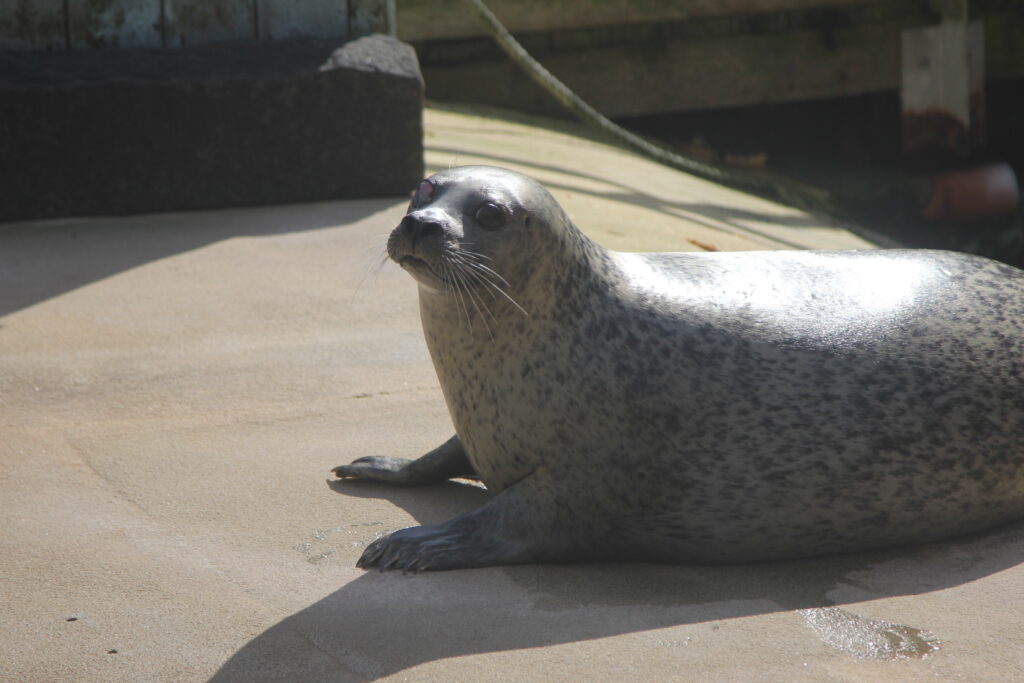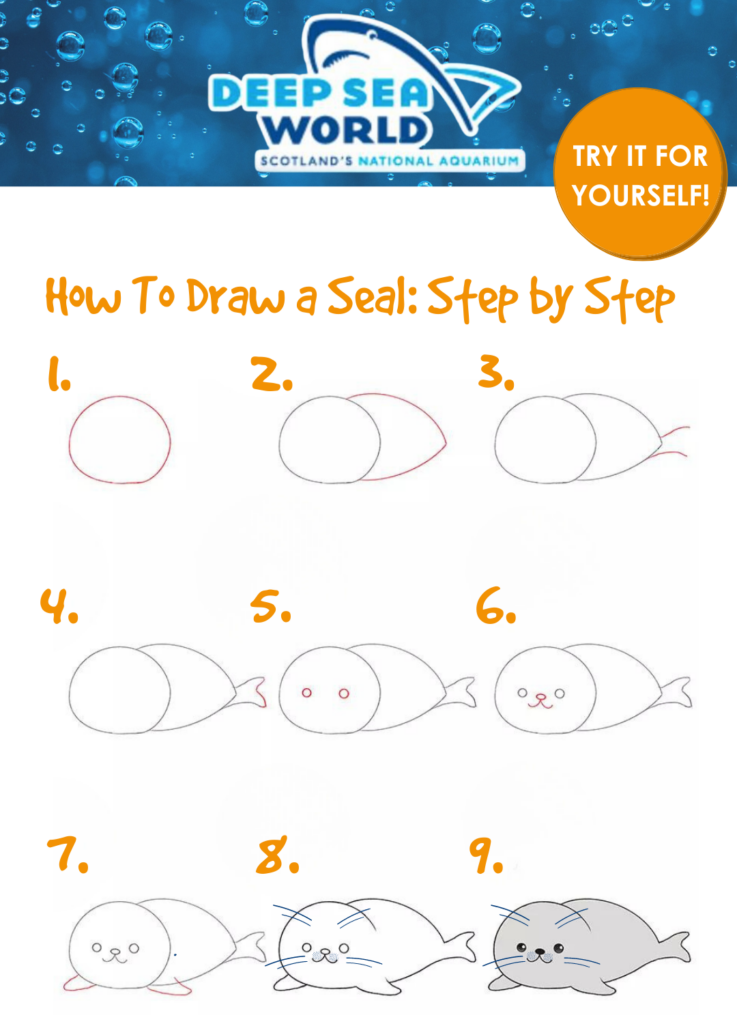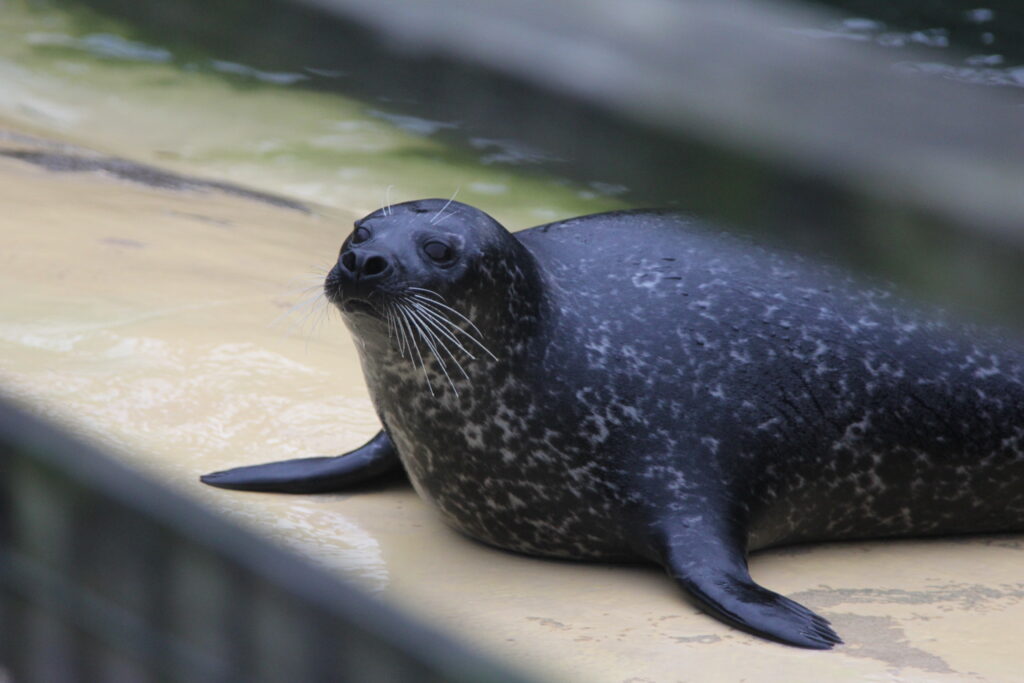
Seals are one of our favourite aquatic animals here at Deep Sea World. Why is that? Mainly because they’re so cute, but we also love them because there are so many interesting facts and figures we can learn about them.
With four flippers, a healthy layer of blubber, and sensitive cat-like whiskers on their snouts – seals are often referred to as the ‘puppies of the ocean’. And it’s easy to see why with their adorable round faces and an all-over squishy appearance!
Here, we’ve given you a quick and easy-to-follow guide for how to draw your own seal, as well as giving you a few interesting facts to tell your friends and family!
How to Draw a Seal
Want to be able to draw a cute seal? Of course you do!
Follow our easy-peasy step-by-step instructions below and you’ll soon be the proud owner of your very own seal drawing…

What will I need?
To start off with, you’ll need the following items:
- Pencil
- Colouring pencils/pens
- Eraser
- Sheet of paper
Step 1
The first step is super simple. Start by drawing a circle just left of the centre of your page. This will be the head of your seal, so you can draw it pretty big.
Top tip: Use something circular like the bottom of a cup to do this. Seals have very round heads, so this will help you get the shape right!
Step 2
Next, you’ll need to draw the body. To do this, draw two curved lines off the right-hand side of the head, these should meet in a point somewhere around the middle of your circle.
You should now have the body and head of your seal down on the paper!
Don’t worry if your lines aren’t perfect, at this stage, we’ll clean everything up once you have your basic outline.
Step 3
At this stage, you’ll want to start outlining the tail. Mark out two curved lines from the end of the body, making sure one line faces upwards and the other goes downwards.
Step 4
Connect the lines we just drew to finish off the tail. This should dip inwards towards the body around the middle point.
Step 5
Now we can move on to the face of your seal and give it some life!
Start by adding two small circles evenly spaced in the centre of the face. These will be your seal’s eyes.
Step 6
Continuing with the features of the face, add in a small oval for the nose. Then draw two small, curved lines coming from the centre of the bottom of the nose. Make sure to draw these in opposite directions.
Step 7
Next, we’ll be drawing the fins. The left fin should be drawn in the bottom left corner of your seal’s head, while the right fin should slightly overlap the body on the other side of the head. The lines for your left fin should connect with the head, while the right fin will only need to connect on the left-hand side of it.
That’s a lot of lefts and rights!
Step 8
Now it’s time to clean everything up and add the smaller details!
At this stage, you can clean up your lines with the eraser and also rub out a small section of the head that’s connected to the body. See our step-by-step visual for help if you get stuck with this.
Don’t forget to add in some little dots above each side of the mouth and four lines on the face for the whiskers!
Step 9
Your seal drawing should really be starting to take shape by this point.
All that’s left to do is colour in your drawing if you want to. Most seals are grey or blueish in colour, so if you really want to make yours life-like, reach for these kinds of colours. You can also go over the outline in pen to really make it stand out. Fill in a section of the eyes with a black pencil or pen, leaving a small white dot in the top right corner to finish it off.
And just like that you’re done!
Our seals at Deep Sea World
Planning a visit to Deep Sea World soon? Bring your seal drawing along and compare it to the real-life version once you get to our Seal Harbour exhibit! If you’ve followed our steps, it should be a pretty close match.
Our three resident seals at Seal Harbour are Laura, Benji and Cody. They’re always happy to give a warm, fin-flapping welcome to all our wonderful visitors. Whether the seals are playing in the 3-metre-deep pool or sunbathing outside on their beach, you’re sure to catch a glimpse of each seal’s very obvious personality shining through.

The trio are all common seals, but we don’t think there’s anything common about them at all. At Deep Sea World, you can see their special bond with each other and our incredible Aquarists that train, feed, and look after them.
10 Fun Facts About Seals
As we’ve said, there are so many exciting things to learn about seals. From their daily habits to their hunting tactics – you’ll never run out of things to find out.
Ready for some more exciting facts and figures about these aquatic creatures? Let’s dip our fins in and get started!
- Seals are warm-blooded and like to spend most of their time in the sea, but they don’t always need to stay wet.
- A thick layer of fat called blubber keeps them super warm, which is how they can survive so well in such cold temperatures. Although the extra weight can mean that they look a little bit clumsy when they’re out on dry land, it also acts as a great way to store food for longer and helps seals float better.
- They’re impressive divers! Seals can dive really deep underwater and stay down there for up to two hours. They also have specially adapted eyes that help them see better underwater than they can out in the open.
- Seals don’t have feet or paws like many animals do. Instead, they’ve developed webbed flippers that let them glide gracefully through the water.
- Their cat-like whiskers help seals skilfully hunt and feed using underwater vibrations.
- Baby seals are called pups, male seals are called bulls, and female seals are called cows.
- These carnivorous animals mostly eat fish, birds, and shellfish.
- There are 32 different species of seal living all over the world, and many live close to the British coastline.
- They let their noises do all the talking! Seals can communicate really well with each other by using clicking or trilling sounds.
- Most seals usually live for around 25-30 years, but the girls usually outlive the boys.
Eager to keep learning about the so-called puppies of the ocean? Our Guide to Seals is full to the brim with even more interesting facts!
For more information about us or to book discounted tickets to Deep Sea World, visit the homepage.
